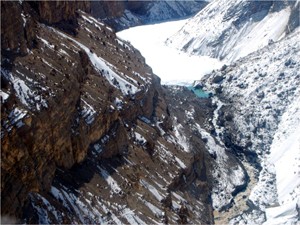Excelsior Correspondent

ZANSKAR, Apr 1: Averting a major tragedy, a joint team of Army, Air Force, NDMA and Civil Administration has finally succeeded to create an artificial channel facilitating flow of water from the lake formed due to massive landslide at 13000 feet altitude over a major distributary of Zanskar river.
This 75 m long channel, two meter deep and two meter wide, was created with the help of controlled blasting using 175 kg of explosive by the task force, which worked relentlessly for five days in temperatures lower than minus 25 degree and high wind chill.
The artificial channel through the landslide area has facilitated flow of water to the downstream side in an uninterrupted manner from the lake formed. The flow is currently being closely monitored.
It may be recalled that the crisis had loomed large over the far flung Zanskar valley due to a massive landslide that had occurred at 13,000 feet altitude, over a major distributary of Zanskar river, located 100 km east of Padam in January this year. The landslide caused complete blockage in the river, resulting in accumulation of more than 30 million cubic meters of water and forming a 15 km long lake, along the river. It was feared that a sudden bursting of the landslide would cause unimaginable catastrophe, due to flooding in Zanskar river, leading to submersion of villages, loss of livelihood and damage to life and property.
The matter was immediately brought to the notice of the Central Government by the State to seek assistance. Consequently, the National Crisis Management Committee declared the situation to be a ‘national crisis’ in first week of February and constituted an expert committee under the aegis of NDMA, to carry out technical assessment of the situation and prepare an action plan for execution, to avert any crisis.
After aerial and ground reconnaissance of the landslide, coordinated by the Army from Leh, a decision was taken to carry out controlled blasting and create a breach in the landslide, so as to facilitate flow of water through it, thereby mitigating the threat of flooding and sudden breach, Defence spokesman Col S D Goswami said.
Given the urgency, risk involved and need for assured success, the Indian Army was called upon to take the lead and coordinate activities for execution of the plan, for creating the breach. A Composite Task Force comprising specially selected and trained personnel from the Army, Air Force, NDMA and State/ local administration was formed to execute the task. The Fire and Fury Corps of the Army was given the overall charge of this joint operation. The whole operation was codenamed as “OP PHUKTAL”
The area being cut off during winter months, the entire operation had to be maintained by air. 500 sorties of Army and Air Force helicopters ferried 38 tons of load over more than 300 hours, under extremely hazardous and demanding flying conditions, in support of the operation. A camp of area 10m x15m was established on a ledge on the rock face near the Landslide site. On establishment of the camp, the composite task force immediately swung into action.
The successful completion of this operation is a testimony to the synergized efforts of the joint task force of Army, AF and NDMA in conjunction with the civil administration. Due to the joint efforts of the Army, Air Force, NDMA and the Civil Administration, a major calamity has been averted.

